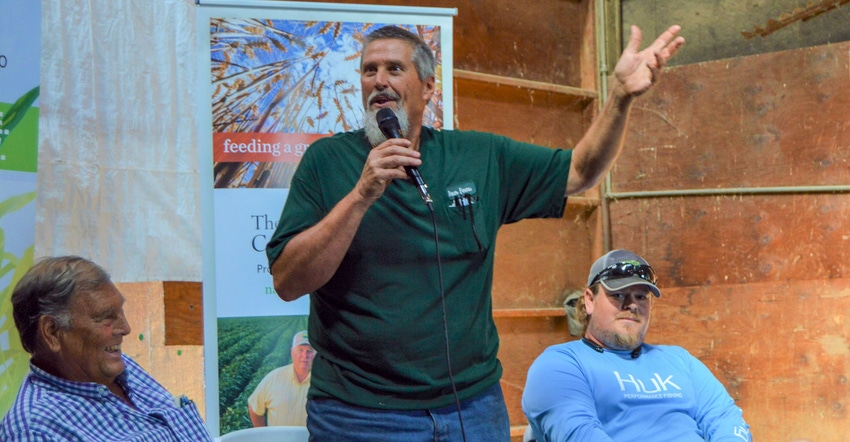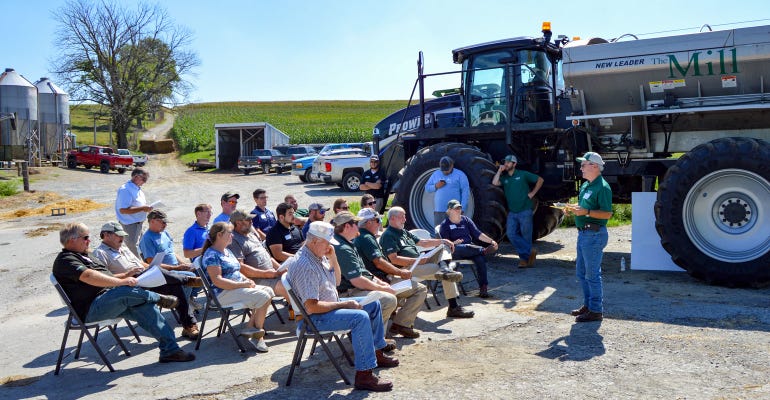October 8, 2019

By Katie Turner
As with many York County farmers, Bob Buser carefully balances crop nutrient needs with manure and fertilizer applications to maximize economic and environmental returns.
“Knowing what nutrients the plant needs and putting them there is key. If you add nutrients that a plant doesn’t need or spread liquid nitrogen with no ground cover, you’re just throwing money and nutrients away,” said Buser, who raises hogs and cattle, and has a row crop operation.
Buser has started using a product called Pit Pro, produced by Verdesian Life Sciences, to help stabilize the nitrogen in his hog manure before and after application. The product increases the consistency of the manure, allowing for better pumping and long-term availability of nitrogen to crops.
He also uses more than 200 soil samples and 30 tissue samples a year to monitor nutrient needs on his 1,700-acre farm.
Data is vital
Buser, along with farmers John C. Johnson and Mike Kurek — part of a farmer panel at a recent PA-4R Alliance event — said he needs the best data to make management decisions for his crops.
4R technologies allow Kurek “to take himself out of the equation” and rely on the numbers.
Numbers make sense for the farmers’ bottom lines, too. One of the biggest challenges identified by the panel in coming years is the increasing economic pressure of high input costs and low commodity prices.
“The fertilizer check is the hardest check to write,” said Kurek, who grows row crops and several hundred acres of orchards at Susquehanna Orchards in Delta, Pa. Practices such as Veris soil mapping and tissue sampling help target fertilizers and minimize waste.
The three farmers rely on their agribusiness advisers to explore new technologies while also prioritizing educational opportunities such as field days and online resources. Kurek said that he also learns a lot about new technologies on YouTube.
Johnson emphasized the importance of soil health in utilizing nutrients efficiently on his farm in Stewartstown, where he manages corn, soybeans and wheat on 700 acres of row crops. His family has been experimenting and utilizing cover crops and no-till practices since 1949.
“I want to grow something in the field that promotes life,” he said.
A better understanding of nitrogen
Improving soil health adds an additional complexity to nitrogen management.
“As long as we have soil biology, we will face nitrogen losses,” said Eric Rosenbaum, executive director of the PA-4R Alliance. “While some loss is to be expected, 4Rs serve to help us maximize crop uptake.”
Nitrogen losses occur from ammonia volatilization in applied manure and denitrification under wet conditions. Rosenbaum, through his Rosetree Consulting, works with farmers to assess the economic impact of processes such as volatilization when manure is surface applied versus injected. His analysis showed over $15 in the value of increased nitrogen availability in fields where manure is injected, emphasizing the economic incentive of using the right placement.
Corn silage acres are typically the worst in terms of nutrient losses. Up to $24 worth of nitrogen per acre is available after silage harvest, and this can be either lost via leaching or held in place with a cover crop.
While nitrogen uptake by corn slows down in late summer, microbial activity is peaking, meaning more nitrogen mineralization and potential for leaching.
 4R ECONOMICS: Ben Hushon of The Mill talks about economic factors in relation to 4R nutrient management.
4R ECONOMICS: Ben Hushon of The Mill talks about economic factors in relation to 4R nutrient management.

Denitrification is also occurring more frequently than we might think — ponding isn’t necessary; if pores are 60% full of water, it can occur.
Nitrogen-use efficiency is around 50%, meaning that half of available nitrogen is not utilized by crops. While this is an improvement over the 35% efficiency of years past, this highlights room for improvement in terms of both nitrogen utilization and pushing crop yields.
Environmental and economic impacts
Ben Hushon of The Mill said there are many economic factors to consider when making nutrient management decisions on a farm.
Agribusinesses have a vested interest in seeing their farmer clients expanding and making a profit, and companies such as The Mill and Growmark FS recognize the importance of prioritizing water quality benefits.
“We need to stop passing the blame and own our part of the responsibility as the agricultural industry. We need to lead,” Hushon said.
Turner is the agricultural program manager for The Nature Conservancy in Pennsylvania.
Source: The Nature Conservancy, which is solely responsible for the information provided and is wholly owned by the source. Informa Business Media and all its subsidiaries are not responsible for any of the content contained in this information asset.
You May Also Like




